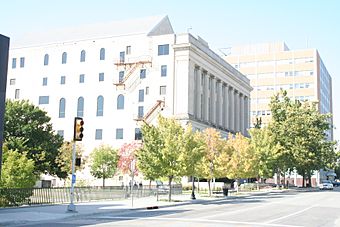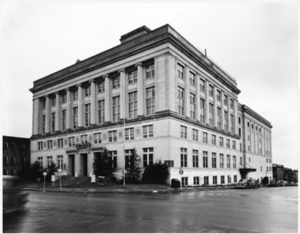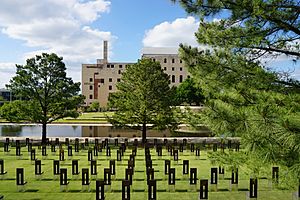The Heritage (Oklahoma City, Oklahoma) facts for kids
Quick facts for kids |
|
|
India Temple Shrine Building
|
|
 |
|
| Location | 621 N. Robinson Ave., Oklahoma City, Oklahoma |
|---|---|
| Area | 1 acre (0.40 ha) |
| Built | 1923 |
| Architect | Layton, Hicks & Forsyth |
| Architectural style | Classical Revival |
| NRHP reference No. | 80003286 |
| Added to NRHP | March 26, 1980 |
The Heritage, once known as the Journal Record Building and the India Temple Shrine Building, is a beautiful building in Oklahoma City, Oklahoma. It was finished in 1923 and added to the National Register of Historic Places in 1980.
The building was damaged during the 1995 Oklahoma City bombing. Today, part of it is home to the Oklahoma City National Memorial Museum. The rest of the building is used for modern office spaces.
Building History
The India Temple Shrine Building was built in 1923 by different groups of Masons in Oklahoma City. Masons are members of a worldwide organization that focuses on friendship and community service.
The first Masonic group in Oklahoma City started in 1890. By 1919, there were 16 groups in the city. They decided to combine their money to build a large temple for all of them.
They hired a well-known local architecture firm, Layton, Hicks and Forsyth, to design the building. Construction began in October 1922 and was finished the next year. It cost $1.3 million to build.
During the Great Depression, a time when many people lost their jobs and money, the Masons had to leave the building. It stayed empty for almost 10 years.
In December 1945, the building was sold at an auction to Joe D. Morris. He was the president of the Home State Life Insurance Company. Morris paid $201,000 and turned the building into offices.
The building was sold again in December 1977 to Dan Hogan, who owned the Law Journal Record Publishing Company. More changes were made inside the building in 1978.
Impact of the Oklahoma City Bombing
On April 19, 1995, the building was badly damaged in the Oklahoma City bombing. This attack destroyed the nearby Alfred P. Murrah Federal Building.
The bomb was so powerful that 20 blocks of downtown Oklahoma City had to be closed off. The India Temple Shrine Building was full of people when the bomb went off.
The roof was blown off, some floors fell, and glass was everywhere. Luckily, no one died in this building, though some people were seriously hurt.
After the bombing, the City of Oklahoma City bought the building using money from federal disaster funds. A big effort was made to save the structure.
The building was empty for five years, with its inside open to the weather because of the damaged roof and broken windows. A non-historic part of the building on the west side was removed.
In 2000, the western part of the building was fixed up. It became the home of the Oklahoma City National Memorial Museum. This museum is connected to the National Park Service.
The rest of the building stayed mostly empty for over 20 years. Then, in 2015, Heritage Trust Company bought it for $4.255 million.
Now called The Heritage, the building went through a $30 million renovation. It is now a Class A alternative office space, which means it's a very high-quality and modern office building.
Building Design and Look
The Heritage building is a six-story structure built in the Neoclassical style. This style is inspired by ancient Greek and Roman buildings. It measures about 260 feet (79 m) long and 140 feet (43 m) wide.
Like other Masonic temples, the outside was designed to look classical. It had tall, decorative columns on the front. The building was made of large cut stones, giving it a strong and timeless look.
The north and east sides of the building are made of limestone. The south and west sides are made of red brick. The top three floors on the east side have windows set back, columns, and a projecting ledge.
The inside of the building was also very fancy. Rooms and halls were decorated in different styles, like Egyptian, Greek, Roman, and Byzantine.
When visitors entered from Robinson, they found a large lobby. A wide hallway led to the Shrine Auditorium, which was the main part of the building.
The Shrine Auditorium had 2,062 seats. It had a stage that was 44 feet (13 m) by 80 feet (24 m) and 2,400 lights. It also had a large pipe organ with 3,000 pipes that cost $30,000. It was said to be the second-largest auditorium in the American West.
By 1947, most of the fancy decorations were gone because of remodeling. However, the auditorium was kept and used as a theater and cinema.
The theater was popular at first, but its finances got worse. In 1952, the auditorium was taken apart, and the space was turned into offices.
In 2000, the western one-third of the building was renovated to become the Oklahoma City National Memorial Museum. The museum opened on February 19, 2001. Its entrance is on the west side of the building.
A part of the second floor was left unrepaired. This allows visitors to see the actual damage caused by the bomb blast.
In 2015, the rest of the building was renovated. Many of the original marble features were kept, like the lobby floor and the stone steps. Marble that the city had stored in the basement after the bombing was found and is now used as a backdrop for art in the lobby.
A big change to the building's look was adding a glass box to the top. This created a new sixth floor with a 750-square-foot rooftop terrace. An internal staircase and skylights made the fifth floor, which was originally an attic, much more useful.
- "Journal Record" in Encyclopedia of Oklahoma History and Culture






